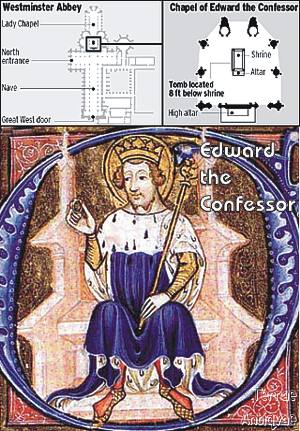Descubren la tumba original del rey Eduardo el Confesor

Londres, La tumba original de Eduardo el Confesor (1003-1066), rey de Inglaterra desde 1042, ha sido descubierta en una olvidada cámara del sótano de la Abadía de Westminster, en Londres, gracias a un estudio arqueológico, señala hoy el diario británico "The Independent".
Sus restos fueron depositados en dicha iglesia en el año 1066 pero hasta ahora el lugar original del sepulcro era un misterio, ya que su cuerpo fue trasladado de sitio dentro de ese edificio en los siglos XII y XIII.
Gracias a un reciente estudio arqueológico en la Abadía de Westminster, basada en una tecnología avanzada con radares, la tumba original ha sido hallada en una olvidada cámara del sótano.
Warwick Rodwell, arqueólogo que lidera el estudio, declaró a "The Independent", que se trata de un descubrimiento "extraordinario" y sin precedentes históricos.
Fuente: Agencia EFE mcg/vg/ma / Terra.com, 2 de diciembre de 2005
Enlace: http://www.terra.com/noticias/articulo/html/act288296.htm
--------------------------------------
(2) Radar pinpoints tomb of King Edward the Confessor
The ancient tomb of Edward the Confessor, one of the most revered of British saints, has been discovered under Westminster Abbey 1,000 years after his birth.
The original burial chamber of the Anglo-Saxon king, who died in 1066, months before the invasion of William the Conqueror, was revealed by archaeologists using the latest radar technology.
The existence of a number of royal tombs dating back to the 13th and 14th century was also discovered beneath the abbey, the venue for nearly all coronations since 1066.
The forgotten, sub-terranean chambers were located during conservation work on the abbey's medieval Cosmati mosaic pavement around the high altar.
Dr Warwick Rodwell, the abbey's consultant archaeologist, said the find was "extraordinarily exciting".
Until now archaeologists had assumed that the original tomb of Edward the Confessor was near the present high altar, because medieval records referred to him being buried there. It has now emerged, however, that the position of the altar was moved by Henry III in the mid 13th century. The archaeologists have located the original tomb 10 feet behind the present altar, under the shrine built by Henry III in 1269, which still contains the remains of the saint.
"We have never been able to locate the original tomb of Edward until now," said Dr Rodwell. "The Victorians tried to find out more about what tombs were under here, but they simply did not have the technology to do it. The mystery around the location of the crypt has been running for many years. Every day brings new insights and new facts." Dr Rodwell said an archaeological team had been examining the construction of the Cosmati pavement, which dates from 1268, using a very high-frequency radar to a depth of about 20 inches. The power of the radar was intensified to examine deeper sections of the pavement.
"Little did we expect that, by using a lower frequency radar, we would find chambers, vaults and foundations of such fascinating historical interest and dating back to the very founding of the abbey, over a millennium ago," said Dr Rodwell.
There are no plans to excavate the tomb because any such work would destroy the medieval pavement.
The discovery, made in October, has delighted the abbey as it has been marking Edward the Confessor's anniversary with a series of events.
Although not among the better known kings - his reign was relatively peaceful - his presence in British history has endured.
The principal royal crown is still called St Edward's crown, and the Coronation Chair is sometimes called St Edward's chair, even though both were made long after his death.
The son of Ethelred the Unready and Emma, the daughter of Richard I of Normandy, his family was exiled to Normandy after the Danish invasion of 1013 and he was largely educated there.
When his half brother, Hardecanute, died in 1042, he was acclaimed king. On his death he was succeeded by Harold, who was killed at the Battle of Hastings nine months later.
Edward's reputation for sanctity grew after the Norman conquest, and he was canonised by Pope Alexander III in 1161.
Edward was patron saint of England for more than four centuries, until 1415 when he was replaced by St George.
The archaeological team is now preparing further investigations to establish the purpose, history and content of the main tomb and the other chambers, graves and coffins they have found.
The Dean of Westminster, the Very Rev Wesley Carr, said: "It is another reminder of how abbey history and humanity are packed together."
Fuente: Jonathan Petre, Religion Correspondent / © Copyright of Telegraph Group Limited 2005.
Enlace: http://portal.telegraph.co.uk/news/main.jhtml?xml=/
news/2005/12/02/ntomb02.xml&sSheet=/news/2005/12/02/ixhome.html
0 comentarios